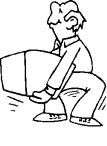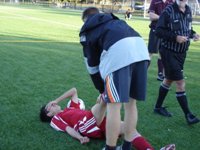Growing pains are a very common complaint in young children and adolesents. Approximately 4-50% of all children and adolesents from the age of 5 to 14 years have complaints of some type of growing pains. Growing pains are usually a result of rapid growth. Inflammation can occur around the site of tendon insertion. The tendon will also pull on the growth plate, causing inflammation and pain. "Bone" aches and pains are common in the evening time and when the child is trying to sleep. Young athletic children will also experience increased pain during times of increased activity. Common causes of growth related pain in young athletes is Osgood-Schlatter Disease and Sever's Disease.
Southwest Orthopaedic Physical Therapy Information Headquarters
Leslie Boone
Recent Posts
Low back pain caused by improper lifting is a common occurance in the work place and home enviornment. Maintaining a health back througout life can be achieved by carefully paying attention to your lifting technique and regular exercise for good phyiscal fitness and strength. Follow these 10 simple steps to help avoid pain caused by lifting.
Anyone with an injury or disability wants the best rehabilitation to regain their lost function and return to productive living. The Certified Hand Therapist (CHT) credential offers assurance to the public that the therapist has achieved a high level of competency in the profession and attends continuing education seminars to stay current within the field of hand therapy. Certification is voluntary, available to occupational or physical therapists, and involves meeting rigorous standards. Because of the the requirements to become a CHT, these therapists demonstrate a dedication specific to the profession of hand therapy. There are 5,294 Certified Hand Therapists in the United States, most of whom are Occupational Therapists, and their focus is based from the definition and scope of practice adopted by the Hand Therapy Certification Board in 2009.
A sprained ankle can happen very quickly and suddenly, when the foot is twisted or turned in unexpectedly. Ankle sprains are the most common foot injury and the most common orthopaedic injury seen by doctors. A sprained ankle can occur during an athletic event or just by a missed stepping on an uneven surface.
Physical Therapists vs. Physical Therapy Assistant vs. PT Technician
When receiving therapy you will be initially evaluated by a physical therapist (PT) who will set up an individualized treatment and exercise program to meet your specific needs. Once established with a physical therapist, you will often also receive treatment from a physical therapy assistant (PTA) or guidance during your exercise program from a physical therapy technician.
Topics: physical therapy
SWOPT and Kinesio Tape at National Indoor Competition
Southwest Orthopaedic Physical Therapy and Kinesio Tape were at the USA Track & Field Indoor National Competition in Albuquerque, NM the weekend of February 26-27, 2011 taping athletes for their events. The event was held downtown in the Convention Center, full of athletes from all over the globe and all types of events from running to throwing to jumping. During Saturday's events, there were two local physical therapist and Kinesio Taping Practitioners on hand to help out the athletes, David Garcia, PT, CKTI and Leslie Boone, MPT, CKTP.
Topics: sports, kinesio tape
In-home physical therapy vs. out-patient physical therapy
When considering therapy after surgery or injury, or healing from aches and pains, one can choose between in-home physical therapy and out-patient physical therapy.
Topics: physical therapy
We have all heard that drinking water is very important. During the winter months with the colder weather, we tend to not drink enough and can quickly become dehydrated. Over half of all Americans are chronically dehyrated and most of us even mistake our bodies need for thirst as hunger.
Kinesio Tape has become very popular as a method of taping joints and sport injuries since the olympics. Kinesio® Tex Tape is an elastic therapeutic tape developed by Dr. Kenzo Kase over 35 years ago in Japan. Since then, Kinesio® Tex Tape Gold™ has become the standard for therapeutic and rehabilitative taping.
Topics: sports, kinesio tape, injuries
Are you considering a total knee replacement or recently have had a total knee replacement? An exercise program designed and guided by a physical therapist can help improve your motion, strength and functional abilities and decrease your pain and swelling.
The first goal of physical therapy after a total knee replacement is to decreased pain and swelling and increased range of motion. After this is achieved, therapy will then focus on strengthening and gait training.
There are 5 basic exercises that you can begin after your knee replacement to get you started down the road of recovery:
- Heel Slides--While lying on your back, gently slide your foot towards your bottom, bending your knee. When you start to feel tightness in your knee stop for about 5 seconds and let the joint "stretch" before straighten the knee out. Repeat 10 times.
- Gluteal Sets--While lying on your back with a pillow under your knees, squeeze your gluts together and hold for 5 seconds. Repeat 10 times.
- Straight Leg Raise--While lying on your back with your operative knee straight and the other knee bent, raise your operative leg up keeping your leg stretch. Slowly lower your leg back down to resting position.
- Heel Raises--Standing while holding onto a sturdy object, raises your heels by going up on and down on your toes. Repeat 10 times.
- Hamstring stretch--While lying on your back and keeping your operative knee straight, raise your leg up into the air until you feel a stretch in the back of your leg.
As with any exercise program, it should be performed under the guidance of your health care provider.
If you would like to try these exercises at home, print out your free exercise spreadsheet.
If you have had a total knee replacement or are considering knee surgery and have questions or would like to schedule an appointment, please contact us.
Topics: exercises, physical therapy, surgery















